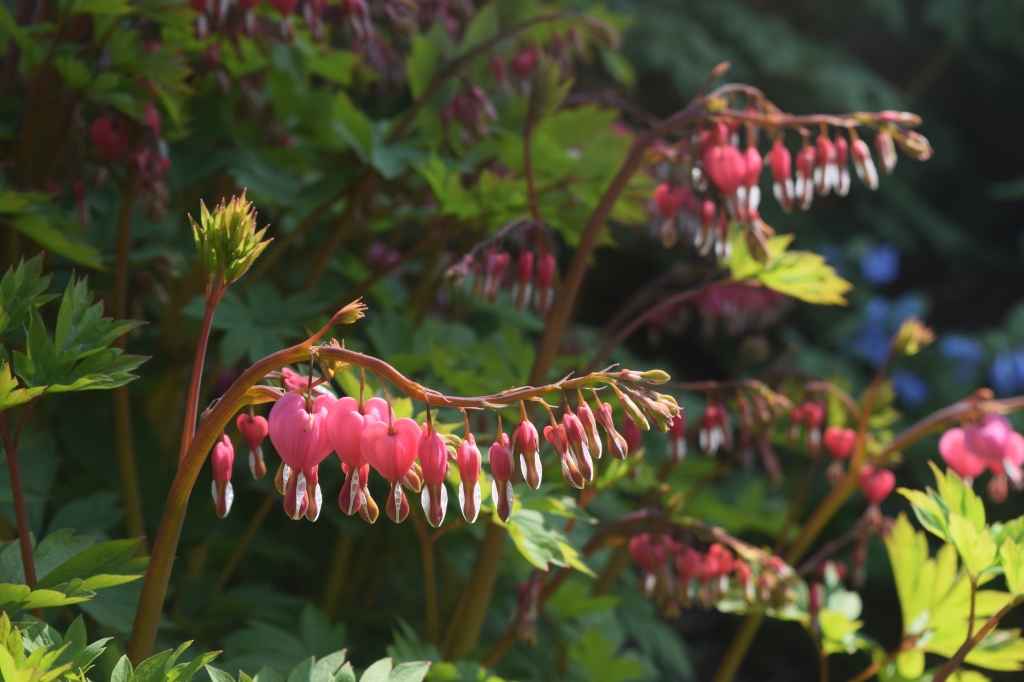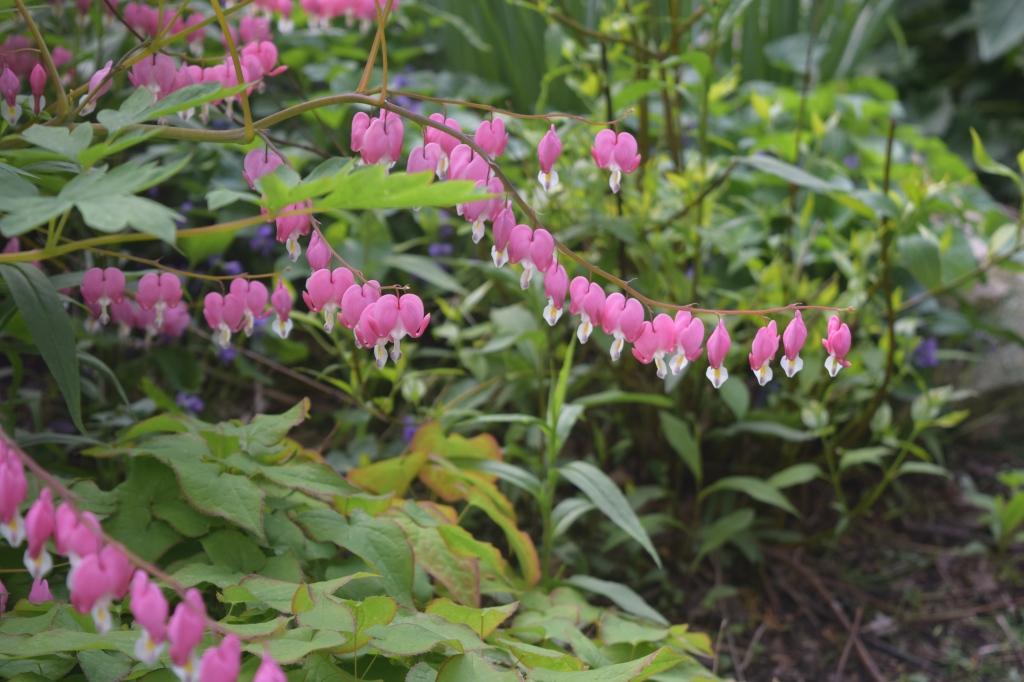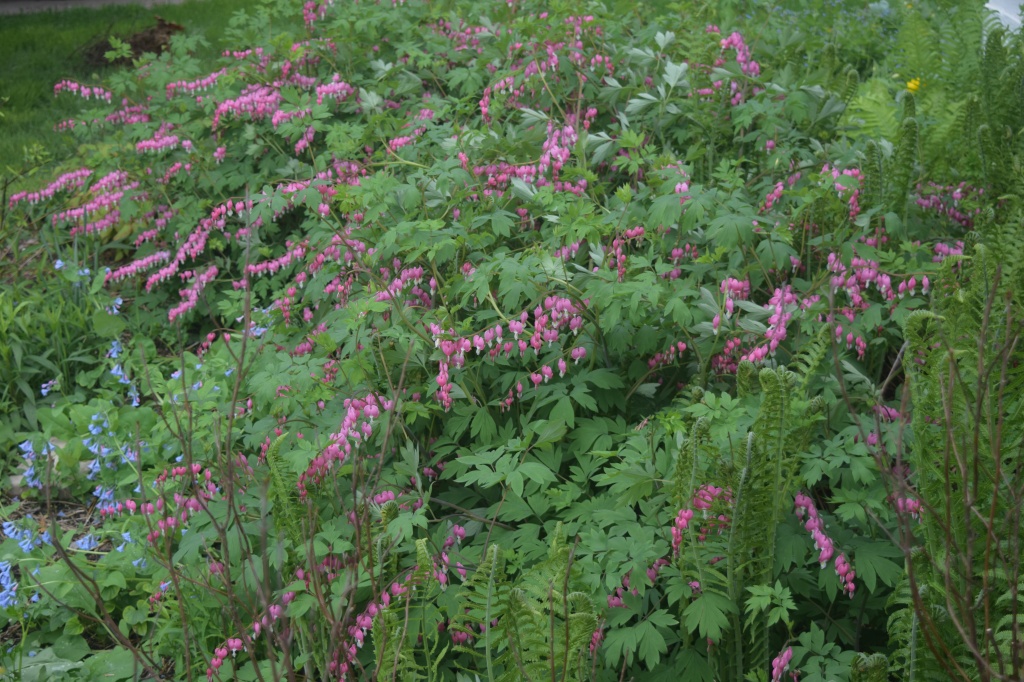My Heart Goes Out to Lamprocapnos spectabilis
Bleeding Heart (Lamprocapnos spectabilis) is one of the stars of my garden in May. This makes it even more unfortunate that it got switched from the genus Dicentra to the genus Lamprocapnos, one of the ugliest plant names in existence. Yes, I’ve carried on about this before, but bear with me.

What makes it even more insulting is that there are eight Dicentra species that didn’t have to switch genera. You know how many species had to switch? Just one. In fact, poor Bleeding Heart is all alone, the only species in the genus Lamprocapnos, which makes it feel both isolated and stigmatized. No wonder it’s bleeding.

Speaking of which, Bleeding Heart didn’t exactly win the lottery in the common name department, either. I mean, Bleeding Heart sounds rather grisly. Another common name is Lady-in-the-Bath, but when you look at the flower it appears this name should be revised to Lady-Upside-Down-in-the-Bath, which raises all kinds of practical questions.

Another common name, which I like, is Lyre Flower. I would use that name except that I fear very few people would know what I was talking about.
Anyhow, I love this plant. in my garden, it thrives in moist soils in shade, though the soil should not be wet over winter. If it’s happy, it makes a mound of bushy loveliness about three feet tall and wide. While it is supposed to be ephemeral, here in zone 5 I find that the foliage lasts until at least late summer if the conditions are right.

There is nothing quite like the heart-shaped flowers that dangle from long, arching stems. These blooms keep coming for a month or more.
And here’s another plus: rabbits leave it alone.
Great companions for Bleeding Heart include Virginia Bluebells (Mertensia virginica), Brunnera (Brunnera macrophylla) and all kinds of ferns.
Bleeding Heart originated in northeast Asia. There is a North American native Bleeding Heart, Dicentra eximia. However (and I know I may upset some friends when I say this), in my opinion the exotic Bleeding Heart is far showier and preferable to the native.
Do you grow Bleeding Heart in your garden?





My Gramma had this in her northern Illinois garden. I always thought it was weird, although it looked like a pirate hat. I much preferred her bright orange Japanese lanterns.
Hmm, I never thought of a pirate hat.
Love these, and just can’t stop calling them dicentra. Yours are gorgeous. My alba (white) ones are especially stunning this year. Damp shade helps them thrive here in Washington as well.
I have some white ones as well. I like them, but love the deep pink best.
You taught me something new, AND made me laugh – both within the span of a couple of paragraphs. I too will continue to prefer to call it Dicentra – at least until I can memorize that other name, whatever it was. I do grow both the white and the red in my garden, and like you said – it lasts a long time if it’s out of the sun. Love it! Who says you can’t have color in the shade?
The hardest time to get color in shade is summer, but that’s what annuals are for.
In the PNW, we have a different native bleeding heart, Dicentra formosa. It gets very ratty in summer but it’s beloved by native plant purists here. I prefer poor old exotic Lamprocapnos, but will probably hold our for calling it Dicentra, as I’m an old dog who doesn’t learn new tricks easily. Thanks for the chuckles, Jason!
Dicentra formosa – forgot about that one. Is it basically similar to D. eximia?
It loks quite similar. Probably a west vs. east variation
Jason, FYI, from Wikipedia (great source of all wisdom, right?):
Dicentra eximia is a flowering plant with fernlike leaves and oddly shaped flowers native to the Appalachian Mountains. It is similar to the Pacific bleeding-heart, which grows on the Pacific Coast.
I love these flowers and have just put in a golden-leafed one. I do hope it spreads as well as yours!
Hope it does well for you!
Sometimes we call it Dutchman’s breeches here. They are great performers. I’ve got white in the shade around the back of the pond, where it lightens and arches nicely.
Dutchmans breeches is the common name we use for Dicentra cucullaria, a very delicate little ephemeral.http://www.illinoiswildflowers.info/woodland/plants/dutchman.htm
Oh that is nice too
Its new name is easy to remember Jason! I grow a white one in a shady spot, I love the way the stems arch and drip with hearts.
Yes, exactly!
I do grow them – and a white variety too – but mine are not as large as your lovely spread. I much prefer the name Dicentra to ‘Bleeding Heart’, which is pretty grisly as you say! So that puts me in a dilemma now and I shall have to settle for the German ‘Weeping Heart’ (Tränendes Herz) instead!
‘Weeping Heart’ sounds awfully sad.
Great post! That name switching can be a bit frustrating. I thought several other Dicentra species were moved in to the genera’s Dactylipampnos, Ichtyoselmis, and Ehrendorferia. Maybe I should check again. I have that published on my Lamprocapnos spectabilis page. You have taken beautiful photos of your Bleeding Heart!!
Oh, Lord! I didn’t know about Dactylipampnos, Ichtyoselmis, and Ehrendorferia. My mind is reeling!
One of my 20 (or so) top 10 favorites! It is a bit touchy here, though, as we often go dry in summer.
I think it doesn’t mind going dormant and comes back just fine.
Finally, I have a plant that you have. 🙂 I have about six pink Bleeding Hearts and just bought a red one. I had a white one but lost it this past winter so I’m checking out local plant sales looking for a replacement. Not to go out in religious right field, but the name Bleeding Heart seems to fit for me because we have it in the gardens near statues of Mary at Church. I tended one yesterday. 🙂
I’ve wondered if the common name had a religious inspiration.
I don’t care what you call it, it’s still a lovely flower…and particularly so in your garden.
Thanks!
Your Bleeding Heart is great. I haven’t tried to grow it in a long time, but I feel for the injustice of changing the name. I see an online petition in your future.
Or maybe a March on Washington.
Alas, at the little house in the big woods, I have not had any luck at all with bleeding hearts. And I love them!
Oh, sorry to hear that.
I love my Bleeding Heart! Deer and woodchucks leave it alone as well!
How can you not love a beautiful plant that doesn’t get eaten by critters?
I’ve grown both forms of Dicentra (nyah nyah nyah nah nah, take THAT, taxonomists! lol) spectabilis in my former gardens and agree with you about it being more attractive; of the two forms, I prefer the white. Here in the Temporary Garden there are a couple of areas of Dicentra eximea (assuming that’s what it is, as I’ve no idea what they actually planted but the appearance matches up in all respects) which is okay but doesn’t make me think “oooh, how lovely this is”, like its larger relative does.
In my next garden I will have Lamprocampos (moment of rebelliousness over, I guess) spectabilis Alba again for sure.
I also have some white Bleeding Heart. I like it but the pink iw my favorite.
I am ignoring the name change. I am too old to change now. The plant is the same and I will cling to that.
A sensible attitude.
Words can never hurt it…it just goes on and on spreading its beauty in spring. Here, it is accompanied by baby tears (kind of a mournful area if you go by names) and lily-of-the-valley.
A garden of bleeding hearts and baby tears. Goodness, that does sound sad.
I hold the UK national collection of dicentra and completely agree with you.
They have done this thing to several innocent dicentras as Belmont rooster observed. I am putting a post on next month about Dicentra macrantha – The Chinese Bleeding Heart. What a dreadful new name it has Ichtyoselmis!
Ichtyoselmis is even worse than Lamprocapnos.
I remember your enthusiasm for Bleeding Heart last year and I’m glad you are still so enthusiastic, it is lovely and I like the way you have mass planted them, perfect.
Thank you. I guess I did write a pretty similar post last year. What can I say? Garden blogs, like gardens, are cyclical.
I didn’t know that they had switched names, but I’m not surprised. There’s going to be a lot of that going on, I’m afraid.
They certainly like your yard! I grow mostly fern leaved bleeding heart these days. It comes up everywhere on its own, but isn’t weedy.
When I tried to grow Dicentra eximia it didn’t do well, perhaps it needs more acidic soil.
I do grow bleeding heart: the pink introduced kind. It is one of my all time favourites. Yours are so lush! Very nice.
Thanks, they do look lush when they are happy.
I grow both the pink and white varieties. Sorry, I can’t be more specific. It was the first flower I “discovered” as a young child. This led to a lifelong love of gardening and horticulture. Even though it is a sad name, I like it. The name never keeps me from smiling whenever I see it blooming.
Some plants really inspire us to make gardens a part of our lives. Bleeding Heart certainly is a charismatic plant with the power to inspire.
Great photos of a great plant! Notice that, while the genus name changed, the species name didn’t — spectabilis, meaning “spectacular”, which it is.
Good point by Jean! Yes, it is spectacular! I’m surprised yours are still going by late summer. Mine are usually browning up by July, which is fine–I just cut them back and something else takes center stage. But my shade must be a little more dry. I think I have D. formosa, which is a little fuller than D. eximia. I agree, the native ones are quite as dramatic as L. spectabilis. But the foliage on the native Dicentras is fabulous!
How long the L. spectabilis foliage lasts varies with intensity and dryness of the summer, I guess.
Lady in the bath? That made me laugh. Can’t say I see it though. This may be a silly question, but are there are blue flower bleeding hearts?
That would be wonderful, but I don’t think so.
Yes, I thought it was only in my dreams. Thanks!
A truly beautiful plant which obviously likes your soil. I don’t grow it at the moment but now that bunny is gone I might reconsider!
Actually, Bleeding Heart is bunny and deer resistant!
I try to grow it and think I have found the spot it likes so will attempt a bit more…it grew perfectly in my shade gardens at the old house…too much sun and clay here but the wall garden seems to be a good spot.
I think it will really appreciate the shade.
Ok so this is another one of those foolproof plants which just outright die for me…. so I grow it I guess, but then have to replace it frequently.
Open up one of the flowers and you get the lady in the bath effect. Give it a google but make sure you add “flower” to the end of your search. Don’t want Judy wondering too much about what you’ve been searching images for 🙂
Ah, thanks for the warning!
Maybe it’s lady-bending-over-in-the-bath. I have a nice one next to the gate by the hosta bed, maybe even the exotic one, as it is more showy than its predecessor (which bit the dust when I had a room added onto the house. Stupid contractors.)
What a gorgeous plant it is, despite the name! I really must get a few, I don’t know why I haven’t to date!xxx
Give it a try!
I refuse to call it anything but Dicentra, which is a lovely name indeed.
Grows great for us too. Often it is a pass down plant. Many are from very old gardens, mine included. As for the name, it is one of the few I call by the original name. Most times when specing the plant for design, the application I use updates and corrects the name on the print. So to me, I just still call it Dicentra and it gets fixed.
I don’t have passalong Bleeding Hearts, but they are some of the first plants I planted in our current garden.
I don’t care what they call it. My bleeding heart Fred is absolutely massive and I love him. He’s like Cher. He goes by one name and we ignore the Latin.
Your Bleeding Heart is named Fred? I like it.
Pingback: How To Grow And Care For The Bleeding Heart Plant -